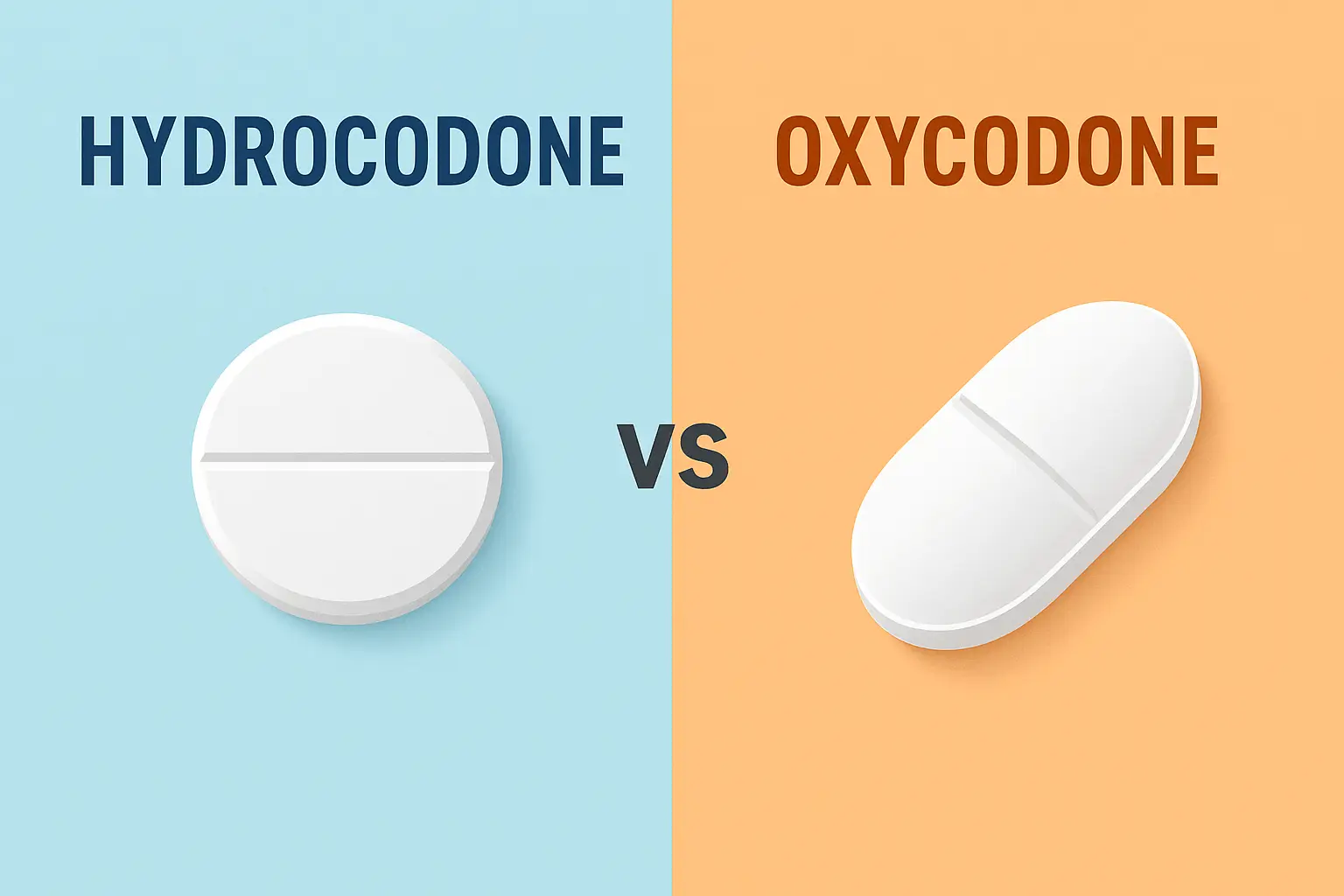 When a doctor prescribes pain medication after surgery, injury, or a major medical procedure, two of the most common opioid options are hydrocodone and oxycodone. Both are highly effective at reducing moderate to severe pain, but they also carry significant risks, especially with long-term use or misuse.
When a doctor prescribes pain medication after surgery, injury, or a major medical procedure, two of the most common opioid options are hydrocodone and oxycodone. Both are highly effective at reducing moderate to severe pain, but they also carry significant risks, especially with long-term use or misuse.
Understanding their similarities, differences, side effects, and potential long-term consequences can help you use them safely and know when to seek professional support. At Safe Haven Recovery, we’ve seen firsthand how these drugs can help when used appropriately and how they can harm when misused.
What Are Hydrocodone and Oxycodone?
Hydrocodone is a semi-synthetic opioid made from codeine. It’s one of the most prescribed pain medications in the United States and is frequently combined with acetaminophen (Lortab®, Norco®, Vicodin®) or ibuprofen. Extended-release versions, like Zohydro ER, are intended for patients who need continuous pain control over 12–24 hours 1.
Oxycodone is also a semi-synthetic opioid, but it’s synthesized from thebaine, an alkaloid of the opium poppy. It’s available in both immediate-release forms for acute pain and extended-release forms (OxyContin) for around-the-clock pain management. Oxycodone is sometimes combined with acetaminophen (oxycodone acetaminophen, brand name Percocet®) or aspirin for additional pain relief 2.
Both drugs are classified as Schedule II controlled substances in the United States, meaning they have legitimate medical uses but a high potential for misuse and addiction.

Key Similarities
Hydrocodone and oxycodone have much in common:
- Mechanism of action: Both attach to opioid receptors in the brain, spinal cord, and other parts of the body, altering the perception of pain and emotional response to discomfort 2.
- Prescribed uses: They’re used for post-surgical pain, injury-related pain, and sometimes chronic pain when other medications are ineffective.
- High misuse potential: Even when taken as prescribed, they can cause tolerance (needing more for the same effect) and dependence (experiencing withdrawal without them).
- Risk of respiratory depression: Both can slow breathing, which can be life-threatening in high doses or when combined with other depressants 3.
- Withdrawal symptoms: Abruptly stopping use can cause muscle aches, anxiety, insomnia, gastrointestinal distress, and intense cravings.
In short, while both medications can be invaluable tools for pain control, they must be used with great caution under medical supervision.
Main Differences
While their effects often overlap, hydrocodone and oxycodone differ in several important ways:
- Potency: Oxycodone is typically more potent milligram-for-milligram than hydrocodone, which may make it more effective for certain severe pain cases 4. However, higher potency can also increase the risk of misuse.
- Formulations
-
- Hydrocodone: Commonly prescribed in combination with non-opioid pain relievers like acetaminophen or ibuprofen. These combinations can limit excessive dosing but also introduce the risk of liver or stomach damage if taken in high amounts.
- Oxycodone: More widely available as a single-ingredient medication, especially in extended-release forms. This makes precise opioid-only dosing possible but may also increase misuse potential.
- Side Effect Profiles: Studies suggest hydrocodone may cause slightly more constipation, while oxycodone may cause more nausea and dizziness 4. These differences are subtle and vary from person to person.
- Patterns of Misuse: Extended-release oxycodone (OxyContin) has been at the center of the opioid epidemic due to its strong, long-lasting effects. Hydrocodone combinations were once the most prescribed painkillers in the U.S., contributing to widespread misuse before tighter prescribing rules were introduced.
Side Effects
Common Side Effects
Both drugs can cause:
- Drowsiness or sedation
- Nausea and vomiting
- Constipation
- Dizziness or lightheadedness
- Itching or mild rash
- Dry mouth
Serious Side Effects
- Respiratory depression
- Severely low blood pressure
- Confusion or extreme drowsiness
- Seizures
- Allergic reactions (facial swelling, rash, difficulty breathing)
Unique Risks
- Hydrocodone combinations: Liver damage from excess acetaminophen 5.
- Oxycodone extended-release: Higher misuse potential due to longer and stronger effects.
Even short-term use can cause side effects, and prolonged use raises the risk of permanent health issues.
Long-Term Risks
Long-term opioid use—even under a doctor’s supervision—can have serious consequences:
- Addiction: Chronic use can rewire the brain’s reward system, making it difficult to stop without help.
- Opioid-induced hyperalgesia: A paradoxical condition where pain sensitivity increases 2.
- Hormonal disruptions: Long-term opioid use can lower testosterone and estrogen levels, affecting mood, energy, and bone health.
- Chronic constipation: Persistent gastrointestinal issues can lead to hemorrhoids or bowel obstruction.
- Mood changes: Depression, anxiety, and cognitive impairments may develop over time.
- Organ damage: Hydrocodone combinations can cause liver damage; oxycodone combinations can harm the stomach lining.
- Overdose risk: Tolerance can lead to higher doses, but a pause in use lowers tolerance, making relapse after abstinence especially dangerous.
Safety Warnings
Opioids like hydrocodone and oxycodone carry black box warnings, the FDA’s strongest alert, about their misuse potential and overdose risks.
- Avoid mixing with depressants: Alcohol, benzodiazepines, and certain sleep medications can dangerously slow breathing 5.
- Special populations: People with breathing problems, head injuries, or liver disease may be at higher risk for complications.
- Pregnancy and breastfeeding: Use during pregnancy can cause neonatal abstinence syndrome (NAS), where newborns experience withdrawal symptoms 3.
- Driving and operating machinery: Both impair alertness and coordination.
- Never stop suddenly: Always taper under medical guidance to avoid dangerous withdrawal 6.
Safe Use and Prescribing Practices
The safest way to use hydrocodone or oxycodone is:
- Strictly following the prescribed dose and schedule
- Storing medication securely to prevent misuse by others
- Regularly reviewing the need for continued use with your healthcare provider
- Exploring non-opioid pain relief options, such as physical therapy, NSAIDs, or nerve blocks
- Proper disposal of unused medication through take-back programs

Hydrocodone vs Oxycodone in Addiction and Recovery
Opioid addiction doesn’t discriminate. It can affect anyone prescribed these medications. Common warning signs include:
- Taking larger or more frequent doses than prescribed
- Using the medication for non-pain-related reasons
- Doctor shopping or obtaining pills illegally
- Social withdrawal or neglecting responsibilities
At Safe Haven Recovery, our integrated approach to opioid addiction treatment includes:
- Medical detox to manage withdrawal safely
- Evidence-based therapies like CBT and motivational interviewing
- Medication-assisted treatment (MAT) with buprenorphine or naltrexone when appropriate
- Aftercare programs for long-term relapse prevention
When to Seek Help
Seek immediate medical help if you notice:
- Slowed or irregular breathing
- Loss of consciousness
- Blue lips or fingertips
If you or someone you know is living with misuse, cravings, or withdrawal, professional help can make the difference between ongoing harm and lasting recovery.
Get Compassionate Support for Opioid Misuse
If you or someone you care about is living with hydrocodone or oxycodone misuse, Safe Haven Recovery offers compassionate, evidence-based care to help you heal. Our team understands the challenges of opioid dependence and is ready to support you every step of the way. Call us or schedule a confidential consultation today.
Sources:
- MedlinePlus. (2023, November 15). Hydrocodone. U.S. National Library of Medicine. https://medlineplus.gov/druginfo/meds/a601006.html
- National Institute on Drug Abuse. (2024, January 10). Prescription opioids drugfacts. National Institutes of Health. https://nida.nih.gov/publications/drugfacts/prescription-opioids
- Centers for Disease Control and Prevention. (2025, August 13). About overdose prevention. U.S. Department of Health and Human Services. https://www.cdc.gov/overdose-prevention/about/index.html
- National Library of Medicine. (2005, April). Hydrocodone versus oxycodone for the treatment of acute pain from fractures. Annals of Emergency Medicine, 45(4), 435–442. https://pubmed.ncbi.nlm.nih.gov/15805317/
- U.S. Food and Drug Administration. (2020, August 31). FDA warns about serious risks and death when combining opioid pain or cough medicines with benzodiazepines; requires its strongest warning. https://www.fda.gov/drugs/drug-safety-and-availability/fda-drug-safety-communication-fda-warns-about-serious-risks-and-death-when-combining-opioid-pain-or
- U.S. Food and Drug Administration. (2019, April 9). FDA identifies harm reported from sudden discontinuation of opioid pain medicines. https://www.fda.gov/drugs/drug-safety-and-availability/fda-identifies-harm-reported-sudden-discontinuation-opioid-pain-medicines-and-requires-label-changes
- U.S. Food and Drug Administration. (2023, October 25). Acetaminophen information. https://www.fda.gov/drugs/information-drug-class/acetaminophen-information






